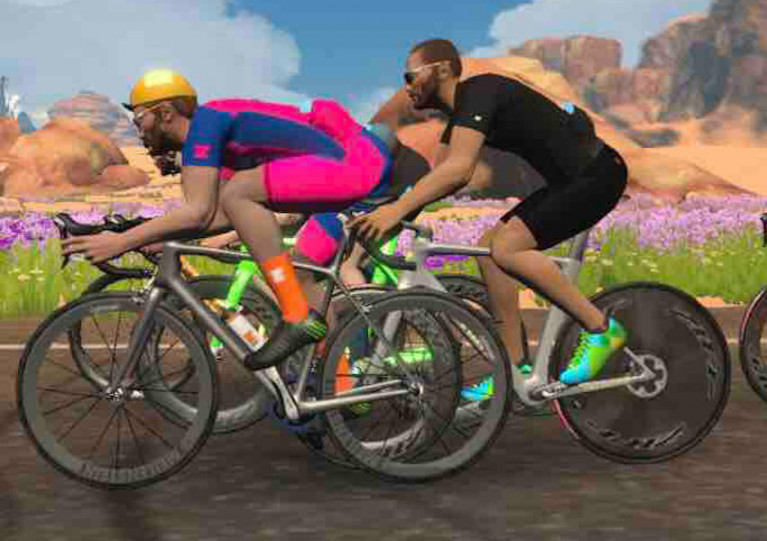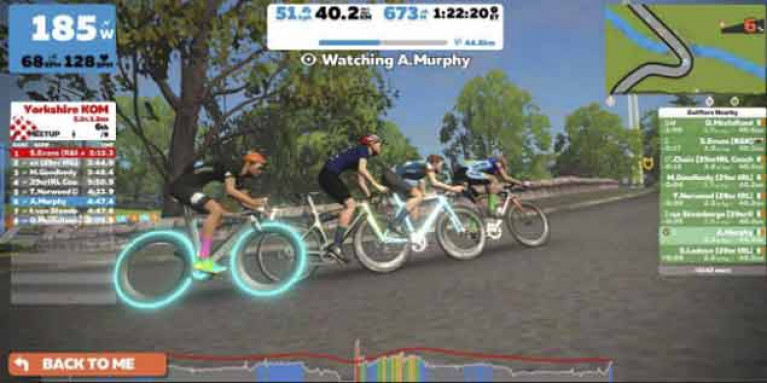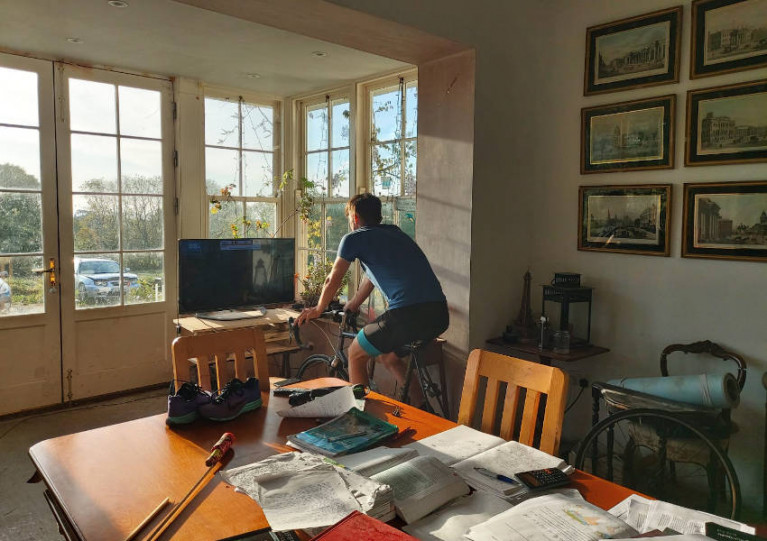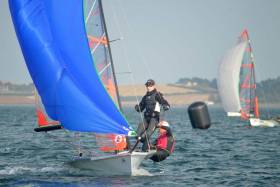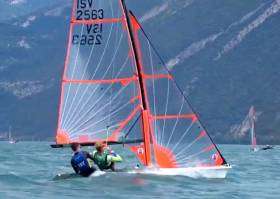Displaying items by tag: 29er
International Performances of Dwyer Matthews & O'Shaughnessy Will Add Extra Spice to 29er Youth Nationals at Royal Cork
The top performance of James Dwyer Matthews and Ben O'Shaughnessy at the 29er Europeans in Italy this week will add extra spice to proceedings at the Investwise youth sailing championships at Royal Cork Yacht Club on Thursday.
The Under 18 pair are lying in fourth place on Lake Garda as Afloat reports here and are within touch of the podium after seven races sailed.
It makes them obvious favourites for Irish youth honours on home waters, especially since the pair also recorded a top 15 finish at the 29er World Championships in Spain in September.
 Royal Cork's James Dwyer Matthews and Ben O'Shaughnessy in action on Lake Garda this week
Royal Cork's James Dwyer Matthews and Ben O'Shaughnessy in action on Lake Garda this week
The majority of a fledgling Irish 29er class are racing at Riva del Garda, this week only returning to Ireland the day before the youth nationals test at RCYC.
Five Irish boats are racing in Italy, with at least three also planning to compete in Crosshaven, so there will be no doubting the new skiff class is up to speed in Cork Harbour.
 Royal St. George Yacht Club's Emily and Jessica Riordan
Royal St. George Yacht Club's Emily and Jessica Riordan
Also competing in Italy and expected in Cork are Royal St. George Yacht Club's Emily and Jessica Riordan and Clementine van Steenberge and Chiara Carra.
As well as Dun Laoghaire, entries from the 29er Fleet hail from Crosshaven, Blessington Sailing Club and a single entry from Northern Ireland.
Double handed turnout
There will undoubtedly be some disappointment over the low turnout of the double-handed dinghy fleet (420 & 29er) for this year's Youth Nationals with only nine 420s and ten 29er entries based on provisional entries for the Royal Cork YC event starting this Thursday.
In particular, the 420 entry is low given it had a record of 21 entries at their National Championship at Howth Yacht Club in August.
The reduced numbers may be accounted for since double handers have only recently attended a Lough Ree Yacht Club symposium designed especially for their needs.
 Ben Graf on the helm and Alexander Farrell on wire shape their champion International 420 for a start. Graf will try out a 29er at the youth nationals at Crosshaven.
Ben Graf on the helm and Alexander Farrell on wire shape their champion International 420 for a start. Graf will try out a 29er at the youth nationals at Crosshaven.
Entries from the 420 fleet hail from; Malahide Yacht Club, Lough Ree Yacht Club, Blessington Sailing Club, Waterford Harbour Sailing Club & Wexford Harbour Sailing Club.
In an outcome from the Lough Ree symposium, perhaps, there's some experimentation between the two fleets going to take place in Cork with 420 National Champion, Ben Graf, crossing over to try his hand in a 29er skiff.
Four-course areas will operate in Cork Harbour Aghada, Curlane Bank, Cuskinny and Roches Point.
Racing begins on Thursday, October 28th, and as well as deciding national honours, the event serves as the second part of a qualifications system to determine Ireland's representative at the Youth World Sailing Championships in Oman this December.
Dwyer & Bateman Take a Top 15 at 29er Worlds as Spain Fills the Podium in Valencia
Royal Cork Yacht Club's James Dwyer and Chris Bateman have finished in the top 15 of 193 sailors from 24 countries at the 29er World Cup in Valencia.
The six days of skiff sailing competition saw eight Irish youth boats in action with Dun Laoghaire's Tim Norwood and Nathan Van Steenberge also in gold fleet with 34th place overall.
The top Irish girls pairing was achieved by Clementine Van Steenberge and Chiara Carra in 53rd place.
Spain achieved 2 gold medals, 1 silver and 1 bronze, with two clubs as the main protagonists: RCN Valencia and RNC Gran Canaria at the top of the podium.
Mateo and Simon Codoner took gold twice: Overall and SUB17, while Martina Lodos and Martina Díaz-Salguero won in SUB17 females. Quicorras Urios and Filippo Benetti, silver and Paula and Isabel Laiseca bronze in Overall.
Spain was awarded the Nations Cup title, which recognises the results at the global level of all national representatives who participated in the World Cup.
Final Top Ten
1. Mateo Codoner / Simon Codoner, ESP, 53 points
2. Quicorras Urios Salinas / Filippo Binetti Pozzi, ESP, 61
3. Jens-Christian Dehn-Toftehoj / Jens-Philip Dehn-Toftehoj, DEN, 65
4. Ian Nyenhuis / Noah Nyenhuis, USA, 87
5. Hugo Revil / Karl Devaux, FRA, 100
6. Claudia Quaranta / Carlo Vittoli, ITA, 101
7. Simon Karlemo / Lasse Lindel, FIN, 102
8. Anton Schmid / Peter Joslin, USA, 104
9. Keo Devaux / Enael Rio, FRA, 105
10. Alvaro Alonso Ortega / Guillermo Castellano Vicente, ESP, 110
Irish placings
15 James Dwyer Chris Bateman
34 Tim Norwood and Nathan Van Steenberge
53 Clementine Van Steenberge and Chiara Carra
68 Emily Riordan Jessica Riordan
74 Lauren O' Callaghan Fiona Ferguson
75 Samuel Ledoux Ethan Spain
114 Ben O'Shaughnessy and Hugh Lynch
129 Johnny Flynn and Ben Horgan
Full results here
Royal Cork female helmswomen finished first and second overall at the 29er Irish National Championships at Royal Cork Yacht Club in Crosshaven this afternoon.
After a ten race series on the Curlane Bank in Cork Harbour, in which brother and sister Lola and Atlee Kohl won four races, the duo was crowned Irish champions on 20 points with a three-point margin clubmates Alana Twomey and Chris Bateman. Still, the winners were only decided in the last race this afternoon.
 Overall winners - the Kohls
Overall winners - the Kohls  Second overall - Alana Twomey and Chris Bateman
Second overall - Alana Twomey and Chris Bateman James Dwyer and Oisín MacSweeney
James Dwyer and Oisín MacSweeney
Most of the racing was held in 12-15 knots, testing sailing conditions.
Rounding out the podium, a third RCYC combination James Dwyer and Oisín MacSweeney, took third overall.
Royal St. George siblings Emily and Jessica Riordan of Dun Laoghaire Harbour were the top female combination in fourth overall in the 15-boat fleet.
 Royal St. George's 29er siblings Emily and Jessica Riordan
Royal St. George's 29er siblings Emily and Jessica Riordan
The youth skiff racing is seen as a step up boat to the Olympic 49ers skiffs.
Cork native and World Sailing Vice President Marcus Spillane, a former President of the International skiff class, spoke to the sailors at the prizegiving.
The 29er event is one of the Cork 300 events postponed last year and sponsored by AIB and Mervue Laboratories.
There was a training camp in the club in the week leading up, which many of the competitors attended.
29er Irish National Championships at Royal Cork Yacht Club Photo Gallery
The 29er Class Association finds itself caught between Irish Covid restrictions and the International Class Association, which is seeking a ranking listing by May 15 for Irish youth entries for this year's World and European Championships.
The Association has written to all those who have registered an interest in being part of the process.
The International Class has also asked the Irish Class to present a list of three teams for each regatta, by the 15th of May. There is more interest from Irish members than slots available, which have been limited by international Covid restrictions. So an 'On The Water' evaluation was decided on by the Class Association in order to create a ranking system.
However, Irish Covid inter-county travel restrictions have caused difficulties in doing this.
"We have not been able to host an assessment day for the 2021 29er World and European Championships. This is due to the current travel restrictions still in place in Ireland. All those who have registered an interest in being part of the process have been contacted regarding this. It is a very fluid situation, one which has us fitted in between National restrictions and International Class desires.
"We have no firm date set for this process as yet as we are trying to work with the International 29er Class to remove the need for a ranking list within this short timeframe, They currently have asked for a ranking by May 15 for all nations. As travel restrictions are to be lifted on May 10, we have pencilled in May 15 as a possible option should we not be able to get an extension from the International Class," says Matt McGovern for the Irish class Association and a member of the Irish 29er Selection Committee.
The Class is seeking extra places from the International Association.
The World Championships are scheduled for Aarhus, Denmark from July 30-August 7 and the Europeans at CN Valencia, Spain, from August 23-31.
The Notice of Race and entry form are now available for next month’s Dun Laoghaire Regatta, celebrating the National Yacht Club’s 150th anniversary.
This special event, an initiative of all five Dun Laoghaire waterfront clubs, will take place over the weekend of 5-6 September and comprises the Rationel J80 National Championships and Shipman National Championships, as well as the respective Eastern Championships for the SB20 and 29er classes.
The Notice of Race is available to download below, and entry is online via the NYC website HERE.
Round-Ireland Virtual Cyclists Raise Over €7,700 For RNLI As They Eye The Home Stretch
Four Dun Laoghaire-Based 29er sailors have raised more than €7,700 for the RNLI in their virtual cycling challenge.
Last weekend, the quartet of Max Goodbody, Nathan van Steenberge, Sam Ledoux and Tim Norwood — along with their coach Thomas Chaix — took on the epic round-Ireland route on stationary bakes in their own homes.
In just over a week the team have covered a total of 1,700km — and that’s all the more impressive considering they’ve been fitting in biking sessions around their school work.
Along the way they’ve been joined on various legs by fellow 29er team member Leah Rickard, Finn sailor Oisin McClelland, Laser Radial challenger Aoife Hopkins and Olympic silver medallist Annalise Murphy.
But as they enter the home stretch and the remaining 360km to Dun Laoghaire tomorrow afternoon (Tuesday 19 May), the pressure will be on as they will be joined by Dublin-based former pro cyclist and current super coach Matteo Cigala.
Cigala’s 20-year professional career included junior participation in the World Championship representing Italy and stand-out performances for many years in Ireland’s An Post Ras.
As a coach, he supported Greg Swinand in his two successful Irish hour record efforts. He is the founder and head coach of Cigala Cycling and current head of athlete performance at Ireland’s only professional cycling team, EvoPro Racing.
For more on the team’s endeavour and how to support their efforts, see the GoFundMe page HERE.
Annalise Murphy Joins 29er's Virtual Cycle Round Ireland
Olympic sailing silver medalist Annalise Murphy joined four Dun Laoghaire-based 29er sailors and their coach in their bid to ‘virtual cycle’ around Ireland in aid of the RNLI.
As Afloat reported earlier, Max Goodbody, Nathan van Steenberge, Sam Ledoux and Tim Norwood, along with coach Thomas Chaix, have taken on the epic route via every lighthouse around the island of Ireland — but covering the distance on stationary bikes in their own homes.
Last night the Irish sailing superstar from Rio 2016 joined the four boys for an 85 km stretch. Like everyone else, the National Yacht Club dinghy star is adapting to a new life with Coronavirus as Afloat reported previously here as she aims for the Tokyo 2021 Olympics.
Since starting on Saturday 9 May, the 29er boys have already covered the distance from Dun Laoghaire to West Cork — and that’s around their home school commitments, too.
The team aims to complete the 2,000km route — with 14,000 metres of climbing — in 11 days while raising funds for the charity that saves lives at sea.
Annalise is not the only Tokyo Laser trialist to join in either. Howth's Aoife Hopkins has also been on the journey. Donaghadee's Finn campaigner Oisin McClelland was also on the route from Castletownbere with coaching staff tagging along too.
Already exceeding their initial target of €2,000, the team have so far raised over €5,000 to keep the RNLI afloat in uncertain waters.
Four Dun Laoghaire-based 29er sailors and their coach have started their own ‘virtual cycling’ challenge in aid of the RNLI.
Max Goodbody, Nathan van Steenberge, Sam Ledoux and Tim Norwood, along with coach Thomas Chaix, have taken on the epic route via every lighthouse around the island of Ireland — but covering the distance on stationary bikes in their own homes.
The team aims to complete the 2,000km route — with 14,000 metres of climbing — in 11 days while raising funds for the charity that saves lives at sea.
Since starting on Saturday 9 May, they have already covered the distance from Dun Laoghaire to West Cork — and that’s around their home school commitments, too.
Already exceeding their initial target of €2,000, the team have so far raised over €5,000 to keep the RNLI afloat in uncertain waters.
And as they go on they will be joined by an Olympian and former Olympian for various parts of the ride — with rumours of some other big names set to tag along.
“All of us are sailors and appreciate the work of the RNLI, and understand how dangerous and unforgiving the sea can be,” the team said.
“We are thankful for the bravery of the lifeboat volunteers who go out and risk their lives for others in all weathers. It would mean a lot to us if you could support us in this project.”
For more on their endeavour and how to support the team, see the GoFundMe page HERE.
Kohls Win 29er Triple Crown in Much Improved Irish Fleet
The 29er Northerns was raced in Strangford Lough Yacht Club last weekend as part of the 30th RYA NI Youth Sailing Championships as Afloat reported earlier. It was the final event of the '29er triple crowns'. Nine teams competed: 3 all boys, 5 mixed and an all girls crew. The standard of the fleet has progressed at a stellar pace allowing a competitive regatta with many changes of leads.
Saturday started with a lot of wind which rapidly decreased to deliver 3 races in medium conditions. The high number of laps on offer allowed many close battles at marks and the sailors had to be solid on their boat handling to maintain or gain positions.
Elysia O'Leary and Chris Bateman showed skills and speed taking the first race win ahead of Triple crowns leaders Lola and Atlee Kohl. The second race saw the return of ISAFs YW Rian McDonnell-Geraghty and Nathan Van Steenberge to winning affairs with O'Leary-Bateman hot on their heels. The final race of the day saw an increase in wind strength and provided some drama.
"The standard of the fleet has progressed at a stellar pace allowing a competitive regatta with many changes of leads"
The leaders of the fleet did not see a lap had been added on the Race committee boat. The Kohl's siblings, on the other hand, had no hesitation and went on for the extra lap with McDonnell-Van Steenberge right on their transom... Realising their error, 4 boats restarted in hot pursuit. The battle at the front became a 3 way gybing battle with Charlie Cullen and Ben Hogan managing to make the junction with the two leaders. McDonnell-Van Steenberge managed to jump the Kohl's to take the win whilst Cullen-Hogan final attempt to get back to the lead ended up in a capsize just boat lengths from the finish allowing Kohl-Crosbie, the McIlwain siblings and Rickard-Goodbody to slip pass.
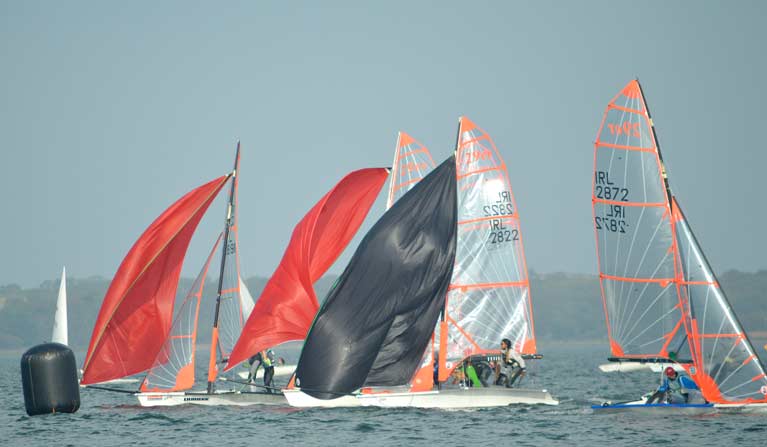 A tight battle at the leeward mark in the 29er fleet Photo: Thomas Chaix
A tight battle at the leeward mark in the 29er fleet Photo: Thomas Chaix
Day 2's forecast was good with a southerly due to head west by midday. The proceedings were a bit slow but the fleet eventually started race 4 in a medium southerly. Early leaders Cullen-Hogan were overtaken by McDonnell-Van Steenberge. The two boys were not seen again scoring their third race win of the event. The Kohl's siblings had to work their way up the fleet and secured yet another 2nd. The next race started in a dropping breeze and the expected right shift came mid race.
The race officer decided it was just that bit too much and the race was abandoned, which set the scene for a final race drama. The equation was simple enough yet required good sailing skills and clear knowledge of the rules. Having added the points, the Kohl's sibling were starting the final race with a guaranteed 2nd overall and a low discard. On the other hand, McDonnell-Van Steenberge were clear leaders yet discarding a high points first race. The Kohl's made their intentions clear in the first beat taking control of the boys windward side and started to sail them off the course in a very skilled and determined fashion. When the pair eventually made it to the windward, The boys had been put into last position with a monumental task in hand to save their event win.
The opportunity came to overtake their tormentor at the leeward of the initial lap when a 420 allowed a split between the two boats. They certainly took their chance and started to look at the fleet ahead with 3 boats still within reach. At the end of the second lap, they managed to overtake 2 boats which was just about enough to reclaim their lead. It was very tense as they held 6th to the finish which meant the countback went to their favour for the Northerns title. Lola and Atlee Kohl settle for 2nd but secured
the Triple crowns overalls. Completing the podium were Elysia O'Leary and Chris Bateman.
The second year of existence of the 29er class in Ireland has seen major progress in the level of skills and the next challenge is now to grow the numbers of partnerships attending open events... In the mean time, everyone is preparing a solid winter of training to develop further their skills... Bring on 2020!
Royal Cork's Kohl & Bateman in Top Ten of 29er Europeans
Royal Cork's Atlee Kohl (18) and Chris Bateman (18) sailing for the US Virgin Islands are seventh overall after the second day of the 29er European Championship on Lake Garda, Italy with winds at 9 to 12 knots, a bit lighter than Monday.
Kohl and Bateman who won the RS200 Nationals in Galway Bay ten days ago have switched roles for the Italian event.
The top Irish duo of nine competing crews is Charlie Cullen (17) and Ben Hogan (17) of the Royal St George Yacht Club.
Seven of the scheduled 9 races have now been completed for the 210 crews competing.
Eight different nations are in the top 10 so far and the gold fleet will see the top 50 crews compete starting today.
Final top ten after 7 races, 1 discard
1. Mathias Berthet / Alexander Franks Penty, NOR, 7 net points
2. Aristide Girou / Noah Chauvin, FRA, 14
3. Ville Korhonen / Edvard Bremer, FIN, 17
4. Marius Westerlind / Olle Aronsson, SWE, 17
5. Finn Walter / Marcus Borlinghaus, GER, 19
6. Ewan Wilson / Finley Armstrong, GBR, 22
7. Zeno Biagio Santini / Marco Misseroni , ITA, 23
8. Jens-ChristianDehn-Toftehoj / Mads Fuglbjerg, DEN, 25
9. Oliver Evans / Will Jarman, GBR, 27
10. Freya Black / James Grummet, GBR, 28
Full Results are downloadable below





























